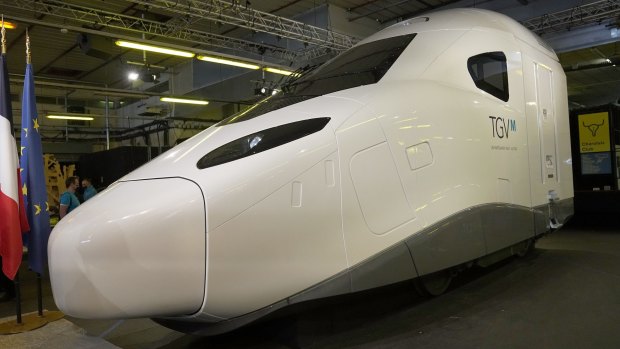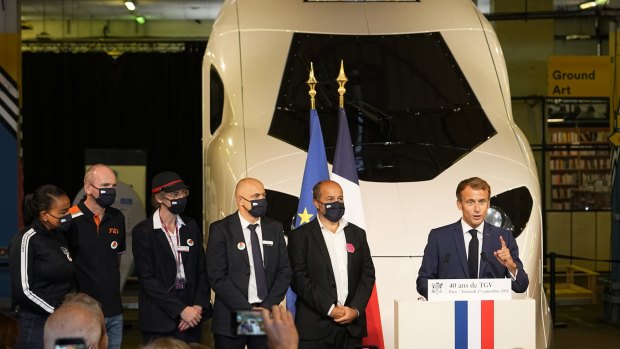This was published 2 years ago
France new TGV fast train: President Emmanuel Macron unveils greener high-speed train

A life-size replica of the new high-speed TGV. The new train will use one fifth less electricity than the current model, while maintaining its top speed of 320 kilometres per hour.Credit: AP
French President Emmanuel Macron on Friday unveiled a mock-up of the next generation of greener super high-speed trains, known in France as TGVs — four decades after the first TGV was launched.
At a presentation at Paris' Gare de Lyon railway station, Macron played up the new train's eco-friendly aspect.
"This decade for the TGV will be about innovation," Macron said, adding that France must "respond to the challenge of moving around by emitting less and promoting new energy forms."

French President Emmanuel Macron (R) speaks at the TGV's unveiling.Credit: AP
Macron spoke in front of a full-scale model of the new TGV M. It will carry more passengers — 740 compared to the current train's 600 — and is planned to enter service in 2024. It will also use one fifth less electricity than the current model, while maintaining its top speed of 320 kilometres per hour.
The ceremony took place 40 years after another French president, François Mitterrand, launched his bold new gamble in technology at the same station — the first TGV, or "Train a Grande Vitesse" (Very Fast Train).
With a line speed of over 270 km/h, according to France's SNCF railway company, that train went on to change the face of modern train travel. It has since been emulated around the world, including recently in the UK's highly anticipated HS2 project.
Macron's government has promised 6.5 billion euros ($10.5 billion) in new investments this year to expand high-speed train lines, and boosting train use has been part of his government's strategy to reduce emissions.
The new train in France is the latest in a series of new developments in high-speed rail around the world.
In June, Spain's state rail operator Renfe launched a new, budget bullet train between Madrid and Barcelona with tickets just €5 ($A7.80).
The train offers four return services daily travelling the 500 kilometres between the two Spanish cities. Travelling at up to 330 km/h, the 438-passenger train takes just 90 minutes to cover the distance during the fastest services. Most services have additional stops along the way and take about three hours.
China, already the world's largest operator of high-speed trains, in January unveiled a new prototype that can travel at up to 620 kilometres per hour.
The train uses high-temperature superconducting (HTS) maglev technology on a163-metre test track in Chengdu.
Also in January China unveiled another new high-speed train, this time designed to cope with extremely cold temperatures.
The CR400AF-G can travel at up to 350 km/h in temperatures as low as minus 40 degrees Celsius. The train, launched on January 6, connects Beijing to cities in the country's north, prone to freezing temperatures in winter. One destination is the city of Harbin, renowned for its annual ice festival and with an average temperature in January of minus 18 degrees.
with AP
See also: Canada's most famous train is leaving the country for the first time
See also: Vegemite and chutney: The overnight train from Sydney to Melbourne
Sign up for the Traveller Deals newsletter
Get exclusive travel deals delivered straight to your inbox. Sign up now.